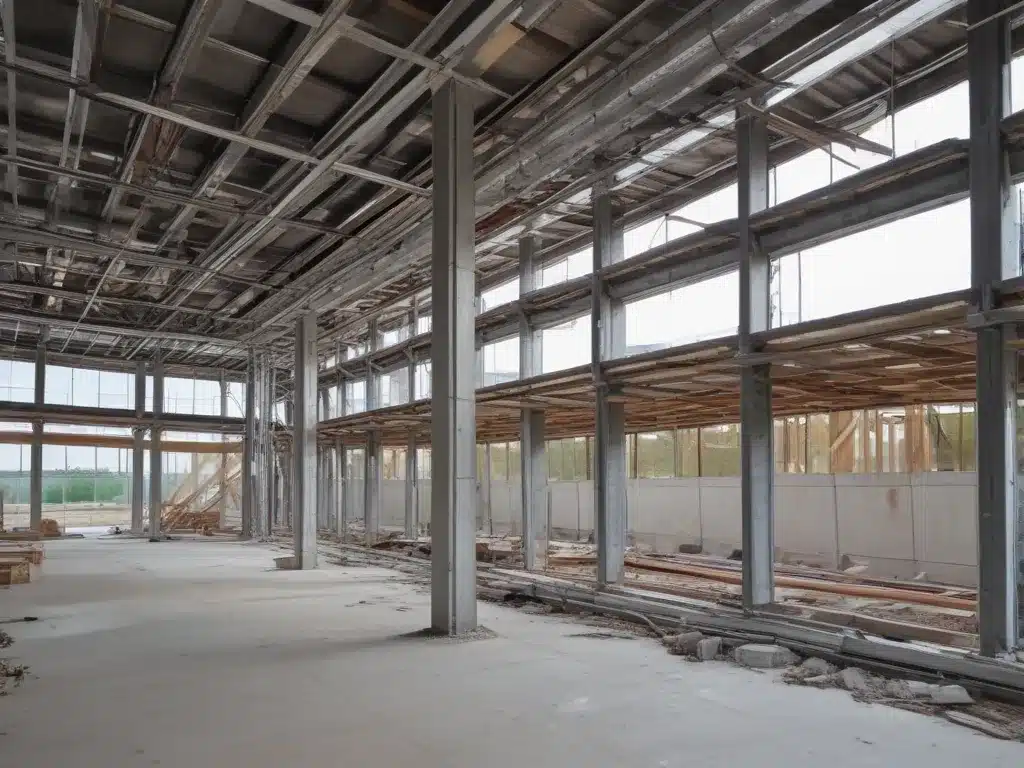
Introduction
H̲a̲v̲e̲ y̲o̲u̲ e̲v̲e̲r̲ w̲o̲n̲d̲e̲r̲e̲d̲ h̲o̲w̲ t̲h̲e̲ b̲i̲g̲ b̲o̲y̲s̲ i̲n̲ c̲o̲n̲s̲t̲r̲u̲c̲t̲i̲o̲n̲ k̲e̲e̲p̲ t̲h̲e̲i̲r̲ p̲r̲o̲j̲e̲c̲t̲s̲ o̲n̲ t̲r̲a̲c̲k̲? Well, let me tell ya, it ain’t easy. But one nifty tool that’s been a game-changer is B̲I̲M̲ (Building Information Modeling). This bad boy is like having a crystal ball that lets you plan and visualize every nitty-gritty detail of your project before you even break ground.
At Atchison Construction, we’ve been riding the BIM wave for a while now, and let me just say…it’s been a total game-changer! Not only does it make our lives easier, but it also helps us deliver top-notch projects for our clients. So buckle up, folks, ’cause I’m about to take you on a wild ride through the wonderful world of BIM implementation!
What is BIM?
Okay, first things first…what the heck is BIM? Well, it’s not some fancy new yoga pose or the latest TikTok dance craze. BIM (Building Information Modeling) is a process that involves creating a digital 3D model of a building or structure. But here’s the kicker – this model isn’t just a pretty picture. Nope, it’s a living, breathing database that contains all the juicy details about the project, from the materials used to the dimensions and spatial relationships between different components.
Think of it as a virtual blueprint on steroids. With BIM, we can visualize every nook and cranny of the project before we even lift a hammer. It’s like having a crystal ball that lets us see potential issues or conflicts before they become actual problems on the jobsite.
Why Implement BIM?
Now, you might be thinking, “Why should I bother with all this fancy schmancy technology? My trusty pencil and paper have been getting the job done just fine for years!” And you know what? You’re not entirely wrong. The construction industry has been around for centuries, and plenty of amazing structures have been built without the help of BIM.
But here’s the thing – the world is changing, and construction needs to keep up. Projects are getting more complex, deadlines are getting tighter, and clients are demanding higher levels of efficiency and quality. That’s where BIM comes in. By implementing BIM, we can:
-
Improve Coordination and Collaboration: With BIM, everyone involved in the project (architects, engineers, contractors, subcontractors, etc.) can access and work within the same digital model. This streamlines communication and ensures that everyone is on the same page, reducing the risk of costly mistakes or reworks down the line.
-
Detect Clashes and Conflicts Early: Remember how I mentioned that BIM acts like a crystal ball? Well, one of its coolest features is clash detection. The software can identify potential conflicts or clashes between different building systems (e.g., HVAC ducts intersecting with structural beams) before they become actual issues on the jobsite. This saves us a ton of time, money, and headaches.
-
Improve Cost Estimation and Planning: With BIM, we can accurately calculate material quantities, plan logistics, and simulate construction sequences. This helps us create more accurate cost estimates and schedules, minimizing the risk of going over budget or missing deadlines.
-
Enhance Visualization and Communication: Let’s be real – some people (ahem, clients) have a hard time visualizing a project from 2D drawings alone. With BIM, we can create stunning 3D renderings and virtual walkthroughs that bring the design to life. This makes it easier for everyone to understand the vision and provide feedback early on.
-
Facilitate Facility Management: BIM doesn’t just stop at construction. The digital model can be used for facility management purposes, providing valuable information for maintenance, renovations, and even energy analysis throughout the building’s lifecycle.
BIM Implementation: A Step-by-Step Guide
Okay, so you’re sold on the idea of BIM. But how do you actually go about implementing it in your organization? Well, fear not, my friend! I’ve got a step-by-step guide to help you navigate the process like a pro.
Step 1: Get Buy-In and Assemble Your Dream Team
The first step to successful BIM implementation is getting everyone on board. And I mean everyone – from the top brass to the boots on the ground. You’ll need to educate your team on the benefits of BIM and address any concerns or resistance they might have.
Once you’ve got buy-in, it’s time to assemble your BIM dream team. You’ll need a mix of tech-savvy individuals, industry veterans, and project managers who can champion the BIM cause. Don’t be afraid to invest in training and upskilling your team – it’ll pay off in the long run.
Step 2: Choose the Right BIM Software
With so many BIM software options out there, choosing the right one can feel a bit like navigating a maze. But don’t worry, I’ve got your back!
When selecting BIM software, consider factors like:
- Compatibility: Make sure the software integrates seamlessly with other tools and platforms you’re already using.
- User-friendliness: Let’s be real, no one wants to spend hours figuring out a clunky interface. Look for software that’s intuitive and easy to use.
- Scalability: As your business grows, you’ll want a BIM solution that can grow with you.
- Support and Training: A good software provider should offer top-notch support and training resources to help your team hit the ground running.
Don’t be afraid to test-drive a few options before making a decision. After all, you wouldn’t buy a car without taking it for a spin first, would you?
Step 3: Develop BIM Standards and Protocols
Once you’ve got your dream team and software in place, it’s time to lay down some ground rules. Developing clear BIM standards and protocols is crucial to ensure consistency and efficiency across your projects.
Your BIM standards should cover things like:
- Naming conventions: No more ‘File123.doc’ – establish clear and consistent naming rules for model elements and files.
- Data organization: Determine how information will be structured and organized within the BIM model.
- Roles and responsibilities: Define who is responsible for what tasks and at what stages of the project.
- Quality control: Establish processes for reviewing and validating the BIM model to ensure accuracy and completeness.
Think of these standards as the rulebook for your BIM implementation. They’ll help keep everyone on the same page and ensure that your BIM efforts are consistent and effective.
Step 4: Pilot and Refine
Rome wasn’t built in a day, and neither is a successful BIM implementation. Before rolling it out across your entire organization, it’s a good idea to start with a pilot project.
Choose a small-to-medium-sized project and use it as a testing ground for your BIM processes and protocols. Pay attention to what works well and what doesn’t, and be prepared to make adjustments along the way.
Encourage your team to provide feedback and suggestions for improvement. After all, they’re the ones in the trenches, using the software and following the protocols day-in and day-out.
Step 5: Rinse and Repeat (and Celebrate!)
Once you’ve successfully completed your pilot project and made any necessary refinements, it’s time to roll out BIM across the rest of your organization.
But don’t just stop there! BIM implementation is an ongoing process that requires continuous improvement and adaptation. As technology evolves and your projects become more complex, you’ll need to revisit and update your BIM standards and processes accordingly.
And don’t forget to celebrate your successes along the way! Implementing BIM is no small feat, and your team deserves recognition for their hard work and dedication.
Real-Life Success Stories
Alright, enough theory – let’s dive into some real-life examples of how BIM has helped construction companies like Atchison Construction knock it out of the park.
The Mega-Mall Makeover
Picture this: a massive, multi-million-dollar renovation project for a sprawling shopping mall. With dozens of stores, intricate building systems, and a tight timeline, it was a logistical nightmare waiting to happen.
But thanks to BIM, our team was able to create a detailed 3D model of the entire mall, including all the hidden elements like HVAC ducts, electrical conduits, and plumbing lines. Using clash detection, we identified and resolved over 500 potential conflicts before they became costly issues on-site.
Not only did BIM help us stay on schedule and within budget, but it also allowed us to provide virtual walkthroughs to the mall owners, keeping them in the loop and ensuring their vision was brought to life.
The Sustainable Skyscraper
In today’s world, sustainability is the name of the game. And when we were tasked with constructing a state-of-the-art, eco-friendly office tower, we knew BIM would be crucial.
Using energy analysis tools within the BIM software, we were able to optimize the building’s design for maximum energy efficiency. We simulated everything from daylighting levels to HVAC loads, tweaking the model until we achieved the perfect balance of sustainability and occupant comfort.
But that’s not all! The BIM model also allowed us to plan and coordinate the installation of cutting-edge green technologies, like solar panels and rainwater harvesting systems, with precision.
The Historic Renovation
Breathing new life into historic buildings is always a delicate dance. You want to preserve the character and charm of the original structure, while still making it functional for modern use.
That’s where BIM came in handy during our renovation of a century-old courthouse. Using laser scanning technology, we were able to create an incredibly accurate 3D model of the existing building, capturing even the tiniest details and nuances.
From there, our team was able to overlay the proposed renovation plans, ensuring that any new additions or modifications seamlessly integrated with the historic elements. BIM allowed us to strike the perfect balance between preservation and progress.
Conclusion
Well, folks, there you have it – a behind-the-scenes look at how Atchison Construction and other industry titans are leveraging the power of BIM for better design and planning.
Sure, implementing BIM might seem like a daunting task at first. But trust me, the benefits far outweigh the effort. From improved collaboration and coordination to early conflict detection and enhanced visualization, BIM is a game-changer that can take your construction projects to new heights.
So, what are you waiting for? Embrace the future of construction and join the BIM revolution! Your future self (and your clients) will thank you.





